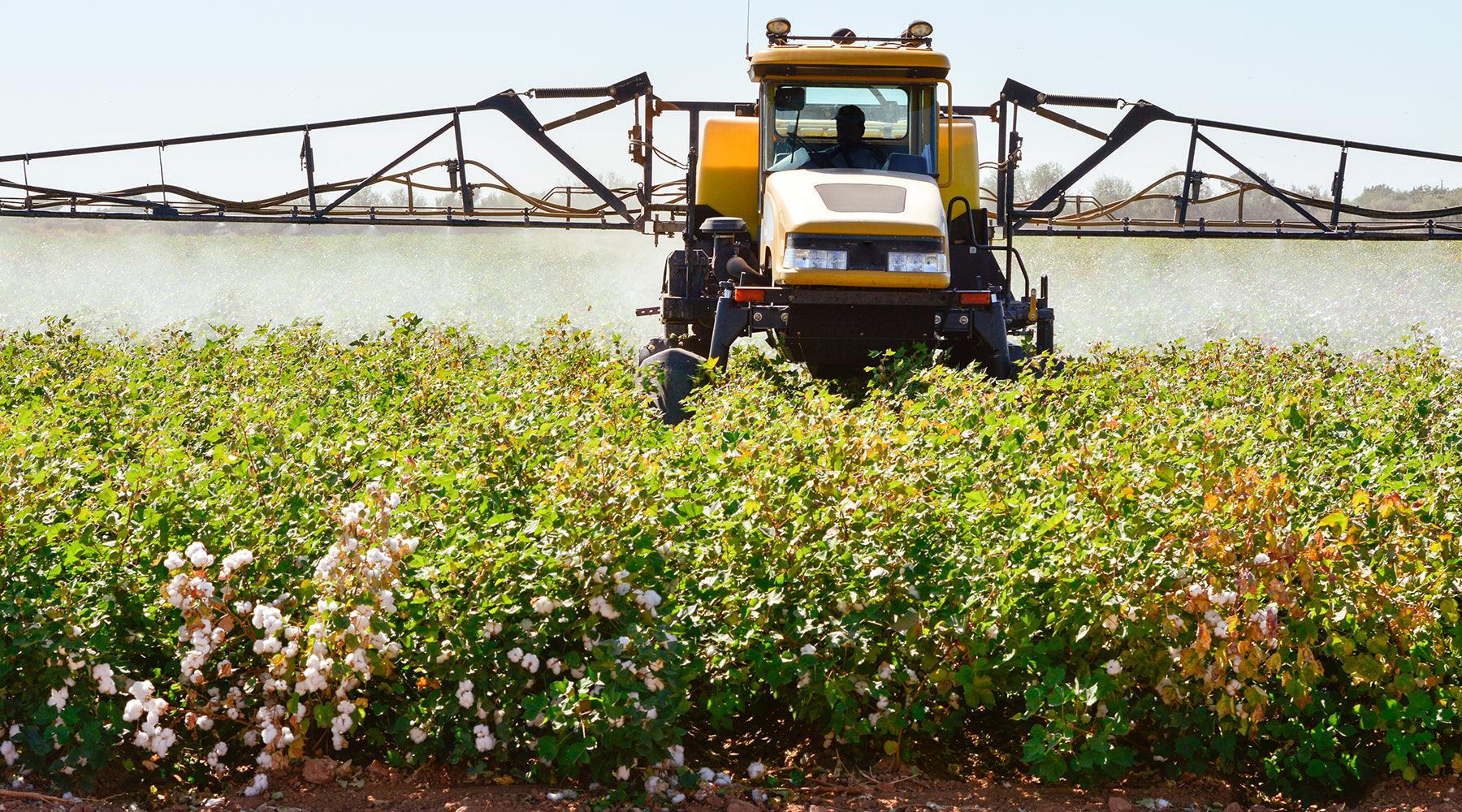
Why Cotton Is Called the World's Dirtiest Crop
Cotton is everywhere—in fact, there is a very good chance you're wearing it right now.
What you might not know is that the cotton industry wreaks havoc on our ecosystem and is socio-politically problematic. From its extreme water needs and often heavy use of pesticides, to the cotton farmers who struggle with economic despair and toxic health effects of agrochemicals, it’s no wonder cotton is often called the world’s ‘dirtiest’ crop.
Let's take a closer look at some of the consequences of our collective cotton addiction.
$2-3 Billions Worth of Pesticides
Bugs love cotton, from bollworms, plant bugs, and stink bugs, to aphids, thrips and spider mites. Cotton farmers' usual solution is to douse crops in $2-3 billions worth of pesticides annually—$819 million of which is so toxic that it’s classified as hazardous by the World Health Organization. To make matters worse, cotton consumes more pesticide than any other single crop—so even though cotton is grown on only 2.5% of the planet's agricultural land, it accounts for 16% of all insecticides used worldwide.

The toxic agrochemicals used in the cotton industry are linked to everything from cancer to infertility and birth defects, and these chemicals don't stay in the cotton fields, either. Because of the heavy irrigation required to grow cotton, chemicals are quickly washed into surrounding rivers and regional groundwater, and entering every aspect of the ecosystem from there—including rainwater. Cotton pesticides now contaminate land, air, food and drinking water in the USA, India, Pakistan, Uzbekistan, Brazil, Australia, Greece and West Africa.
360 Pounds of Fertilizers per Acre
Another drastic measure to kill off pests is to pull the otherwise perennial cotton plant fully out of the ground right after harvesting and start new plants from seed every year. This exterminates any eggs before bugs can hatch. While this may be effective in combating pests, it deprives the soil of valuable nutrients that the decomposition of the roots would otherwise have provided. To replace these nutrients, cotton farmers use an average 360 pounds of fertilizer per acre of cotton field every year. Some of these nitrates are then transformed into nitrous oxide—a greenhouse gas 300 times more potent than CO2.
But fertilizers don’t just go up into the air. They also enter our drinking water and the oceans. Fertilizer overuse has contaminated the drinking water of whole regions of California. San Joaquin Valley, where most of the state's cotton is grown, is particularly hard hit. Californian agriculture generates about one million tons of nitrogen annually. 419,000 tons of nitrogen leach into the groundwater every year where it is converted into a salt known as nitrate. Nitrate can cause serious health issues in babies in particular including lack of oxygen ("blue baby syndrome"), difficulty breathing, nausea, dehydration, and vomiting. In pregnant women it can result in birth defects and pregnancy complications.
Fertilizers also spill into the sea where they create oxygen-depleted "dead zones." These happen when phytoplankton feed on the excess nutrients from the fertilizers resulting in a population explosion. When these die and decompose, bacteria absorbs the water's oxygen making it deadly to animals from fish to crustaceans. In the Gulf of Mexico, we have created an annually recurring dead zone the size of New Jersey.

100 Billion Gallons of Water
Cotton needs a lot of water to thrive.
According to the World Wildlife Fund, it takes no less than 713 gallons of water to produce one cotton t-shirt—this is the equivalent of the water needed to sustain one person for two and a half years. Globally, cotton consumes 100 billion gallons of water every year. In order to provide this amount of irrigation, waterways in many developing countries are diverted to feed the cotton fields, often with devastating effects.
A prime example of this—but far from the only one—is the Aral Sea, which is considered one of the biggest environmental disasters in human history. The Aral Sea was once the fourth largest body of inland water and vital to the surrounding communities and wildlife. But after major rivers that fed the Aral were diverted into irrigation canals to serve cotton farms, the sea turned into a dessert bigger than Belgium, Luxemburg, and the Netherlands combined. Twenty of the 24 native fish species are now extinct and many more fish and bird species are on the brink of extinction. Storms blow about an estimated 43 million metric tons of deadly agricultural chemicals left behind on the barren ground, destroying surrounding plant, animal, and human lives. Doctors Without Borders link downstream pesticides from the Aral Sea to the high incidence of miscarriages and deformities among the four million people living in affected areas. The region also suffers from the highest rate of throat cancer in the world.
Learn more about this man-made disaster in this short but eye-opening documentary from BBC News:
The Human Cost of Cotton
Cotton is linked to a long history of slavery and other labor exploits, and this connection is not just a thing of the past. In India alone, an estimated 450,000 children are made to work in cotton—90% of them girls and 90% of them under debt bondage. These children work 9-13 hours a day and receive no education. The cotton dust in the ginning factories where they work is known to cause lung cancer at an early age. 99% of the world’s cotton farmers live and work in the developing world where illiteracy, poor labelling of pesticides, and inadequate safeguards inflict great damage on vulnerable communities. At least one million agricultural workers are hospitalized every year with acute pesticide poisoning.
Millions of cotton farmers worldwide live below the poverty line. Many are deeply indebted from the high-interest loans they are forced to obtain from loan sharks to buy fertilizers and genetically modified seeds that can cost up to four times as much as conventional seeds. One season of unfavorable weather conditions (or a dip in global cotton prices) can spell disaster for the whole family. Global warming is now exacerbating the problem. In 2013, under extreme financial distress, more than 10,000 Indian cotton farmers took their own lives.
The Unintended Consequences of GMO Cotton
50% of cotton grown worldwide is the genetically modified Bt cotton. In northern China, 95% of cotton is of the Bt variety. Bt cotton contains a gene from a common soil bacterium called Bacillus thuringiensis (shortened to Bt) and produces a toxin that kills cotton's number one enemy, the bollworm (also known as Helicoverpa armigera). This reduces farmers pesticide use and is, in theory, a good thing.
However, as many have warned, genetically modified crops can have unintended consequences—and Bt cotton is no exception. Eliminating the bollworm has allowed its primary competitor, the mirid bug, to thrive. Once considered a minor and occasional pest, the mirid bug (Heteroptera Miridae) is now infecting Chinese dates, grapes, apples, peaches and pears. Now farmers are using more pesticides to kill the mirid bug. Meanwhile, the bollworm is quickly developing resistance to Bt cotton and already impoverished farmers are forced to pay a premium for new GMO cotton seeds.
Plunging the Developing World Deeper into Poverty
So why are these farmers so poor? You'd think that they would have an economic advantage competing with the West. The answer lies in cotton subsidies. Every year, US taxpayers lavish $4 billion on their cotton farmers, in order to slash cotton prices by 50%. A practice begun in response to the Great Depression, US cotton subsidies apply no matter the farmer’s yield (in fact, the practice often rewards the successful)—which means that cotton producers in the poorest regions of the world are unable to compete with the low prices of their rich American counterparts.
What about organic cotton?
While organic cotton is certainly preferable to conventional cotton, it’s far from perfect. For one, it requires even more irrigation than conventional cotton, and has a 30% lower yield. Conventional cotton has improved its yield by 42% over the last 35 years due to improvements in irrigation techniques and biotechnology (GMO). Since organic cotton has not been genetically modified, more plants (and by extension more land) are required to grow the same amount of cotton. More land translates to even more irrigation.
Organic cotton growing also still requires pesticides, albeit organic ones. But these pesticides are less accurate, and often kill off the natural predators of cotton pests. This means that farmers have to use even more of the stuff than conventional cotton farmers, which some studies suggest may ultimately be worse for the environment.
Nevertheless, organic cotton farming is likely a step in the right direction, as it eliminates health risks from exposure to highly toxic pesticides, and farmers receive a payment premium of 10-20% above the standard cotton price, which helps them earn a living wage. However, the organic cotton industry accounts for only 0.2% of world cotton production, and has a long way to go before it becomes a scalable solution.
Why We Use Organic Linen Instead of Cotton
Let's face it—it would be virtually impossible to avoid cotton altogether, even if you tried. But we can all take steps to minimize our dependency on it, and support alternatives that leave a smaller footprint on our planet and its people.
When we started The Modern Dane, we made a commitment: to not be part of the problem—and to be a small part of the solution instead. That guiding principle shapes everything we do, from how we source our materials to how we design, package, and ship our products.
It’s why we chose to make our bedding from certified organic European flax linen—one of the most sustainable fibers in the world. Grown in Belgium, the Netherlands, and northern France, certified European flax requires no irrigation beyond natural rainfall, no defoliants, and no genetically modified seeds. Its cultivation is not only chemical-free but also waste-free: every part of the plant is used, from seed to stalk, making it a true zero-waste crop.
Flax is naturally pest-resistant and requires minimal fertilizer, which means farmers can grow it without resorting to harmful pesticides or synthetic chemicals. It’s a crop that works in harmony with nature—preserving soil health, supporting biodiversity, and emitting significantly less CO₂ than cotton or synthetics.
By choosing certified European flax linen, you're supporting traditional farming practices that put the planet first—and helping protect the landscapes and communities that have cultivated flax for generations. It’s a small act, but a meaningful one. And at the end of the day, we hope it lets you sleep a little better—wrapped in comfort, and grounded in purpose.






Leave a comment
This site is protected by hCaptcha and the hCaptcha Privacy Policy and Terms of Service apply.